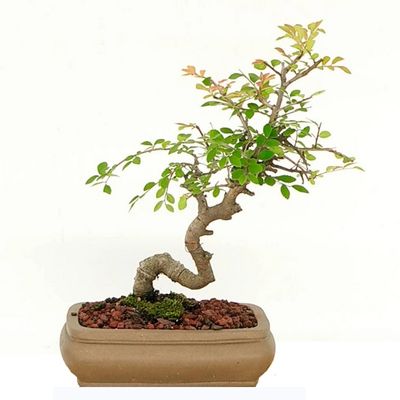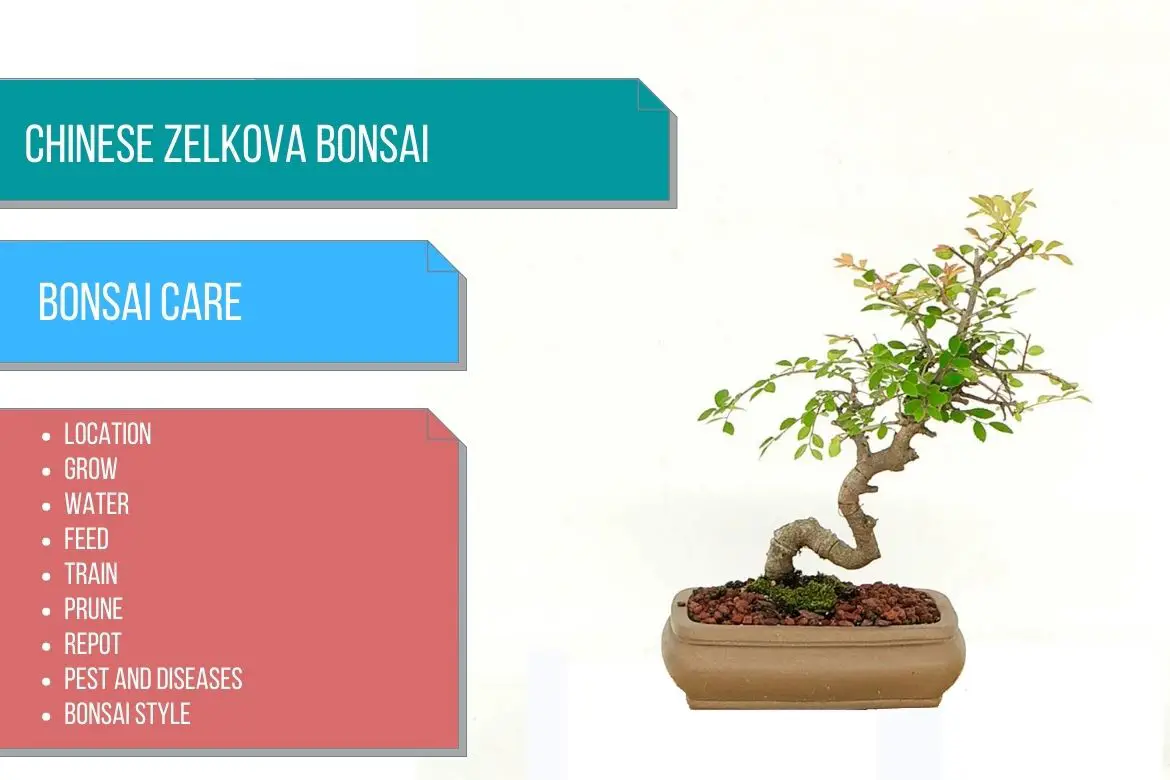
Chinese Zelkova
( zelkova sinica )
Country of Origin : China
Bonsai Styles : Informal upright, clump, group, raft,broom, slanting, semi-cascade
Zone : 6 – 9
A deciduous tree, Zelkova sinica (Chinese zelkova) is considered a tender temperate to subtropical tree.
As long as the tree is cultivated in a warm climate, it will remain evergreen, but if the climate is cold, it will drop its leaves.
The natural growth habit of young trees is ‘vase-shaped’, which turns into a more rounded canopy as the tree matures.
It has glossy dark green leaves that are ovate to elliptic in shape, with sharply serrated margins and rough upper surfaces. During autumn, its leaves turn yellow/orange before falling to the ground.
In the first season, young twigs are glossy brown in color and are covered with dense woolly hair.
This tree sometimes has multiple trunks. The bark of the tree is grayish white when young and as the bark matures, the color changes to grayish green to rich brown. The bark also peels in thin flat flakes. The bark also has small lenticels.
The Chinese zelkova bonsai tree is also very resistant to changes in its growing environment. It also makes for a good indoor bonsai tree.
There is also a slight difference between Chinese elm bonsai and Chinese zelkova bonsai. Almost all the care instructions are same, however, Chinese zelkova is relatively more cold hardy.
Read more about other bonsai trees species in : Bonsai tree care

There are some minute differences between Chinese zelkova (Zelkova sinica) and Japanese zelkova (Zelkova serrata).
(i) In comparison with Zelkova serrata, Zelkova sinica is a smaller tree
(ii) There are 8 to 14 lateral veins per leaf on Zelkova serrata, whereas there are 7 to 12 lateral veins per leaf on Zelkova sinica.
Best location to keep Chinese zelkova Bonsai
The tree can be kept indoors throughout the year if it is placed in a position that is reasonably bright. Exposure to sunlight for almost 6 hours a day is optimum.
In indoors, you can keep the bonsai container in north of west facing window or windowsill.
It is a fairly tolerant plant when it comes to temperature changes.
During the summer, it can be placed almost anywhere outside in almost any position that you choose.
In winters, a good temperature range for the tree is 45°F – 70°F (7°C – 22°C).
Zelkova sinica bonsai is frost hardy and can tolerate frost. However, it will shed its leaves in these conditions.
IMP: Refer sunlight requirements for indoor plants for more indoor gardening ideas. Also, refer to do bonsai trees need sunlight for more indoor and outdoor bonsai location ideas.
Propagation of Chinese zelkova
Zelkova sinica can be propagated using stem cuttings taken in spring or early summer.
Both softwood and hardwood cuttings can be used to propagate. However, make sure that you apply rooting hormone as it greatly increases the chances of rooting.
Plant these cuttings in moist growing medium. The stems will produce roots in 6-10 weeks.
You can also propagate the tree using seeds. You can sow at any time of the year. Sow the seeds in moist compost.
Refrigerate pots for 4 weeks after sealing them in polythene bags.
You will need to move the plant to a propagator or another warm place where it can be maintained at a temperature of 59°F-69°F (15°C-21°C). Seed germination can be unpredictable, but should occur within 1-3 months.
Watering Chinese zelkova Bonsai
Keep the bonsai soil moist throughout the summer. Do not make the soil soggy though.
Depending on your indoor settings, your frequency of watering the tree might vary in summer and in winter.
It is possible to reduce watering during the winter. Do not use calcareous water.
Read watering bonsai tree for more details.
Wiring Chinese zelkova Bonsai
For mature Chinese zelkova bonsai specimens, usually, only pruning is enough to maintain the shape of the tree. However, you can still wire a mature bonsai if you are not happy with the direction of the branch, and you have run out of pruning options.
However, for young trees, wire training can be used to achieve the initial shape.
Zelkova sinica bonsai can be wired at any time of the growing season.
Pruning Chinese zelkova Bonsai
When to prune Chinese zelkova bonsai?
How to prune Chinese zelkova bonsai?
Pruning can be done at any time of the year.
It is recommended that you allow the shoots to grow at least eight to ten pairs of leaves before pruning them back to one or two.
By doing this you will allow the new branches to develop a certain amount of thickness.
Also, mature bonsai trees can be partially defoliated to increase the amount of air and light received by the inner section of the tree.
In spring and early summer, you will see the tree with good growth. Pruning at this time will also encourage good ramification and smaller leaves.
You can also perform some winter pruning as this will give you a clear picture of the ramification.
Keep a clear picture of how you want to see your primary branches on the tree in mind. Choose your primary branches wisely and remove the rest of the branches.
Then work on the spread of the shoots. Ideally the spread of the shoots should be consistent in all the directions.
You can shorten or completely remove the unwanted branches on the upper half of the tree.
Depending on the bonsai style and shape in your mind, you can remove the unwanted branches on the lower half of the trunk.
Remove old small stubs. Apply a cut paste on the large pruning wounds.
Repotting Chinese zelkova Bonsai
When to repot Chinese zelkova bonsai?
Mature Zelkova sinica bonsai can be repotted every 2-3 years in spring, before the new buds have opened. However, younger bonsai specimen preferably should be repotted every year.
As far as root pruning goes, you can perform a little bit of root pruning. Especially remove the old bottom part of the cuttings. (in case the tree was grown using stem cutting).
Remove the higher roots on the trunk and try an keep the roots in one level.
Give the roots a good wash and you can keep the tree in a pot of water till the time you are preparing the bonsai pot.
After repotting the tree, start feeding the tree after 4 weeks. However you can water it immediately. Acidic to neutral soil is good.
You can use a basic free-draining, moisture retentive bonsai soil mix as a potting soil.
Must Read: Bonsai Soil Recipes
Must read : Choosing the right bonsai container
Feeding Chinese zelkova Bonsai
Feed can be applied every 2 weeks in the summer and every 4 weeks in winter.
Read more about bonsai fertilizer and its application.
Diseases and pest of Chinese zelkova Bonsai
Chinese zelkova bonsai tree can be attacked by red spider mites, aphids and black spots.
Black spots are rarely fatal for the plant. But it can cause defoliation of the tree.
Use a systemic insecticide or remove them manually or by a gentle water jet. You can also use some insecticidal soap, soap solution or Neem oil solution.
Chinese zelkova bonsai care
Even though the tree is hardy, the tree will need protection from frost for first couple of winters.
Additionally, late spring frosts can be very damaging, so care should be taken to protect them from that as well.
In addition to being drought tolerant, it is also very tolerant of heavy clay soils.

